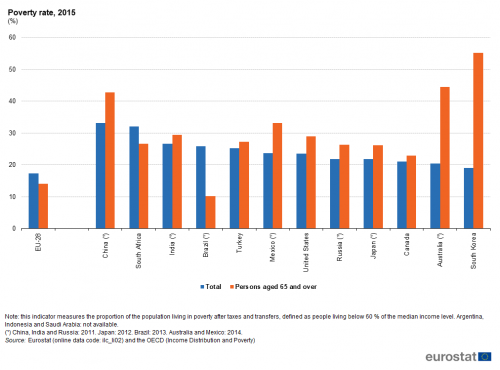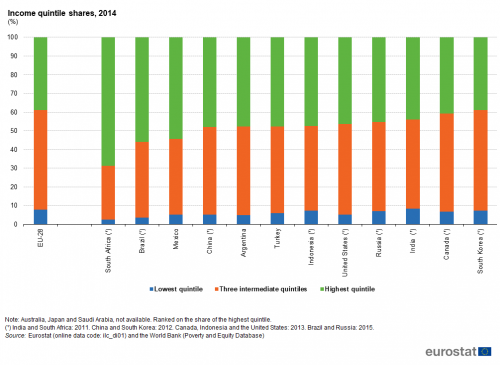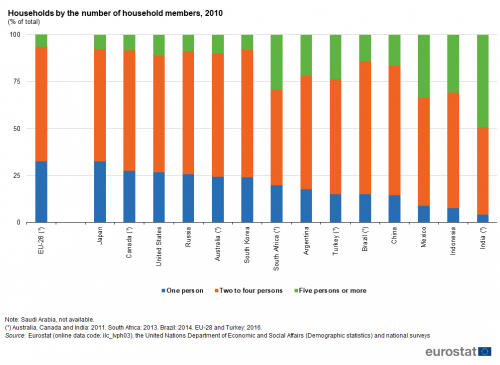Archive:The EU in the world - living conditions
Data extracted in April 2018.
Planned article update: June 2020.
Highlights
The overall poverty rate was lower in the EU-28 in 2015 than in any of the other G20 members.
The widest inequalities in income distribution in 2014 among the G20 members were recorded in South Africa, while the EU-28 and South Korea had the most equitable distributions.
Nearly half of households in India in 2011 were composed of five or more persons, compared with just 6.5 % of households in the EU-28 in 2016.
Poverty rate, 2015
This article is part of a set of statistical articles based on Eurostat’s publication The EU in the world 2018.
The article focuses on living conditions and social protection in the European Union (EU) and the 15 non-EU members of the Group of Twenty (G20). It covers indicators related to income, expenditure, poverty and social protection and gives an insight into societal developments in the EU in comparison with the major economies in the rest of the world, such as its counterparts in the so-called Triad — Japan and the United States — and the BRICS composed of Brazil, Russia, India, China and South Africa.
Full article
Social protection expenditure and poverty
Social protection encompasses all actions by public or private bodies intended to relieve households and individuals from the burden of a defined set of risks or needs. Figure 1 shows the level of social protection expenditure relative to gross domestic product (GDP) for the G20 members in 2015. The EU-28 (2014 data) recorded the highest expenditure on social protection (using this measure), ahead of Japan (2013 data) which was the only other G20 member (among those for which data are available) with a ratio above 20 %. South Korea (2016 data) recorded social protection expenditure of 10.4 %, the lowest among the six non-EU G20 members for which data are available. In these six countries, social protection expenditure relative to GDP increased between the years shown in Figure 1, as it also did in the EU-28. The largest increases in percentage point terms were in Japan (4.9 points; 2005-2013) and South Korea (4.2 points; 2005-2016).
(% of GDP)
Source: Eurostat (spr_exp_sum) and the OECD (Social Expenditure Database)
The overall poverty rate was lower in the EU-28 in 2015 than in any of the other G20 members
Figure 2 shows the poverty rate, calculated as the proportion of the population with an income (after taxes and transfers) below the poverty threshold, where the threshold is set independently in each country as 60 % of the median income level (again, after taxes and transfers). In 2015, the EU-28 had the lowest poverty rate among the G20 members, at 17.3 %. The only other G20 member with a poverty rate below one fifth was South Korea, while the rate was above one quarter in Turkey, Brazil (2013 data) and India (2011 data), and closer to one third in South Africa and China (2011 data).
(%)
Source: Eurostat (ilc_li02) and the OECD (Income Distribution and Poverty)
Among persons aged 65 and over the poverty rate in the EU-28 was 14.1 % in 2015, therefore lower than the overall rate for the total population. This situation was quite unusual, in that the only other G20 members to record a lower poverty rate for older people (than for the total population) were Brazil and South Africa. A particularly large difference between the overall poverty rate and that for older people was observed in South Korea, which had the lowest overall rate (among the non-EU G20 members) but the highest rate for older people. The lowest poverty rate for older people was recorded in Brazil (10.2 %; 2013 data), which was the only non-EU G20 member with a rate lower than that observed in the EU-28.
Household income and expenditure
Figure 3 presents information on income levels compiled by the OECD. Household adjusted disposable income reflects a household’s gross income including social transfers in-kind received (such as education and healthcare) minus taxes on income and wealth and social security contributions. Furthermore, these data have been adjusted to reflect differences in purchasing power between countries, in other words differences in price levels. This adjustment is done by converting data in national currencies to a common currency — United States dollars in this case — using purchasing power parities (PPPs) rather than market exchange rates. In 2016, the United States had the highest annual household adjusted income per inhabitant among the G20 members, followed at some distance by Australia, Canada, Japan and the EU-28.The widest inequalities in income distribution in 2014 were recorded in South Africa, while the EU-28 and South Korea had the most equitable distributions
Figure 4 presents the distribution of income based on income shares, showing the proportion of all income received by the 20 % of the population with the highest incomes (the top or highest quintile), the proportion received by the 20 % of the population with the lowest incomes (the bottom or lowest quintile), and the proportion received by the three intermediate quintiles. Whereas the proportion of income received by the highest quintile was lowest in 2014 in the EU-28 (38.8 %) and South Korea (39.0 %; 2012 data), in all other G20 members for which data are available this proportion exceeded two fifths of the total. Mexico and Brazil (2015 data) reported that the top quintile received more than half of all income while South Africa (2011 data) reported by far the largest proportion among the G20 members as the highest quintile accounted for more than two thirds (68.9 %) of all income.
(%)
Source: Eurostat (ilc_di01) and the World Bank (Poverty and Equity Database)
A commonly used measure for studying income distribution is the income quintile share ratio, which is calculated as the ratio of the proportion of income received by the highest quintile compared with the proportion received by the lowest quintile. Based on the data presented in Figure 4, this ratio ranged in 2014 from 5.0 in the EU-28 and 5.3 in South Korea to 10.0 or more in Argentina, Mexico and Brazil (2015 data), and peaked at 27.6 in South Africa (2011 data).
Household consumption expenditure is the expenditure made by households to acquire goods and services and includes payments of indirect taxes (VAT and excise duties). Figure 5 shows that household consumption expenditure per inhabitant in 2016 was highest among the G20 members in the United States, Australia, Canada, Japan and Saudi Arabia, followed by the EU-28. It should be noted that these data have been adjusted to reflect differences in purchasing power as countries with high levels of household consumption expenditure per inhabitant often tend to have relatively higher price levels too.
(international USD per inhabitant)
Source: Eurostat (nama_10_gdp) and (demo_gind), the United Nations Statistics Division (National Accounts Main Aggregates Database), the OECD (purchasing power parities) and the United Nations Department of Economic and Social Affairs (World Population Prospects: the 2017 Revision)
The share of total expenditure on food and non-alcoholic beverages was particularly low in 2015 in the United States
Table 1 provides information on the distribution of household consumption expenditure for various purposes. Factors such as culture, income, weather, household composition, economic structure and degree of urbanisation can all potentially influence expenditure patterns. In most G20 members the highest proportion of expenditure was normally devoted to food and non-alcoholic beverages on one hand or housing (including also expenditure for water and fuels) on the other. A notable exception to this general pattern was the United States where household expenditure on health had the highest share. The share of expenditure on food and non-alcoholic beverages was particularly low in the United States, as it was to a lesser extent in Canada and Australia.
(% of total household consumption expenditure)
Source: Eurostat (nama_10_co3_p3), the United Nations Statistics Division (Economic Statistics Branch, National Accounts Official Country Data) and national household surveys
Households
Nearly half of households in India in 2011 were composed of five or more persons, compared with just 6.5 % of households in the EU-28 in 2016
Many statistical analyses of social and living conditions focus on households, in other words a person or group of persons living together (but separate from others), regardless of whether they are family members or not. Many factors influence household formation, for example, marriage, divorce, fertility and life expectancy, as well as geographical mobility, economic and cultural factors.
Figure 6 shows that in 2010 more than one quarter of all households in the EU-28 (2016 data), Japan, Canada (2011 data), the United States and Russia were one person households, whereas this was the case for less than one tenth of households in Mexico, Indonesia and India (2011 data). Households with five or more persons were relatively uncommon in the EU-28, Japan, South Korea, Canada, Russia and Australia (2011 data), all reporting that at most one tenth of households were this large; by contrast nearly half (49.5 %) of all Indian households were composed of at least five people.
(% of total)
Source: Eurostat (ilc_lvph03), the United Nations Department of Economic and Social Affairs (Demographic statistics) and national surveys
In Brazil and China, one person households and large households were both relatively uncommon, with more than two thirds of all households composed of two to four people, as was also the case in South Korea despite its relatively high share of one person households.
Source data for tables and graphs
Data sources
The statistical data in this article were extracted during March 2018.
The indicators are often compiled according to international — sometimes worldwide — standards. Although most data are based on international concepts and definitions there may be certain discrepancies in the methods used to compile the data.
EU data
Most of the indicators presented for the EU have been drawn from Eurobase, Eurostat’s online database. Eurobase is updated regularly, so there may be differences between data appearing in this article and data that is subsequently downloaded. In exceptional cases some indicators for the EU have been extracted from international sources.
G20 members from the rest of the world
For the 15 non-EU G20 members, the data presented have been compiled by a number of international organisations, namely the OECD, the United Nations Department of Economic and Social Affairs, the United Nations Statistics Division, and the World Bank. For some of the indicators shown a range of international statistical sources are available, each with their own policies and practices concerning data management (for example, concerning data validation, correction of errors, estimation of missing data, and frequency of updating). In general, attempts have been made to use only one source for each indicator in order to provide a comparable dataset for the members.
Context
The data on living conditions and social protection shown in this article aim to provide a picture of the social situation covering indicators related to social protection, poverty, household income and expenditure, as well as the composition of households and housing conditions. The distribution of income is often used to measure inequalities in society. On the one hand, differences in income may provide an incentive to individuals to improve their situation (for example, through looking for a new job or acquiring new skills). On the other hand, crime, poverty and social exclusion are often linked to income inequalities.
Direct access to
- The EU in the world 2018
- The European Union and the African Union — A statistical portrait — 2018 edition;
- Sustainable Development in the European Union — Monitoring report on progress towards the SDGs in an EU context
- Smarter, greener, more inclusive ? Indicators to support the Europe 2020 strategy — 2017 edition
- Sport statistics — 2018 edition
- Globalisation patterns in EU trade and investment
- 40 years of EU-ASEAN cooperation — 2017 edition
- Monitoring social inclusion in Europe — 2017 edition
- Key figures on the enlargement countries — 2017 edition
- Analytic report on subjective well-being
- Asia-Europe Meeting (ASEM) — A statistical portrait — 2016 edition
- Euro-Mediterranean statistics — 2015 edition
- People in the EU: who are we and how do we live? — 2015 edition
- European social statistics — 2013 edition
- The European Union and the BRIC countries
- The European Union and the Republic of Korea — 2012
- Income distribution and monetary poverty (ilc_ip)
- Monetary poverty (ilc_li)
- At-risk-of-poverty rate by poverty threshold, age and sex - EU-SILC survey (ilc_li02)
- Distribution of income (ilc_di)
- Distribution of income by quantiles - EU-SILC survey (ilc_di01)
- Monetary poverty (ilc_li)
- Living conditions (ilc_lv)
- Private households (ilc_lvph)
- Distribution of household size - EU-SILC survey (ilc_lvph03)
- Private households (ilc_lvph)
- Material deprivation (ilc_md)
- Housing deprivation (ilc_mdho)
- Total population not having indoor flushing toilet for the sole use of their household - EU-SILC survey (ilc_mdho03)
- Housing deprivation (ilc_mdho)
- Social protection (spr), see:
- Social protection expenditure (spr_expend)
- Expenditure: main results (spr_exp_sum)
- Auxiliary indicators (population, GDP per capita and productivity) (nama_10_aux)
- Main GDP aggregates per capita (nama_10_pc)
- Detailed breakdowns of main GDP aggregates (by industry and consumption purpose) (nama_10_dbr)
- Final consumption expenditure of households by consumption purpose (COICOP 3 digit) (nama_10_co3_p3)
- OECD
- United Nations Statistics Division
- The World Bank
